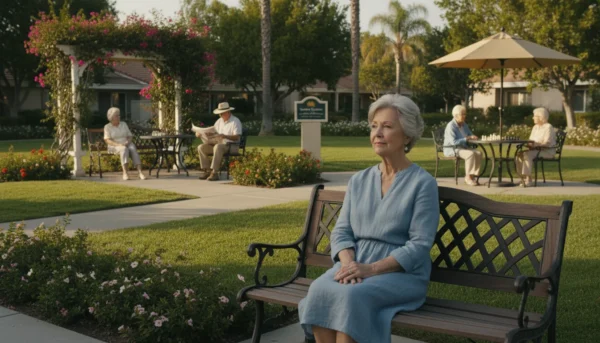Choosing a retirement community is one of the most significant financial and lifestyle decisions you will make. It’s a step toward a vibrant, secure, and supportive future. However, this major investment requires careful diligence. As a financial expert dedicated to helping seniors protect their assets, I’ve seen firsthand how a poor choice can lead to financial strain and distress. The key to making a wise decision is knowing which financial red flags to look for before you sign any contracts or write any checks.
This guide is designed to empower you with the knowledge to identify potential senior living financial warnings. By understanding these risks, you can confidently navigate the process, ask the right questions, and choose a community that is not only a wonderful place to live but also a financially sound home for years to come.
This article is for informational purposes only and is not intended to be financial advice. Please consult with a qualified financial professional or an elder law attorney for advice tailored to your individual situation.

Vague, Complex, or Incomplete Fee Structures
The ‘Why’: A reputable retirement community should be transparent and upfront about all costs. If the fee structure is confusing, or if the marketing representative seems evasive when you ask for a detailed breakdown, this is a major red flag. Vague terms like “ancillary services fee” or “community fee” without clear definitions can hide a host of future charges that can quickly bloat your monthly bill and disrupt your budget. These unexpected expenses are one of the most common eldercare finance risks.
The ‘How’:
– Request an Itemized List: Ask for a complete schedule of all potential fees, including one-time and recurring costs. This should cover everything from different levels of care, meal plans, housekeeping, transportation, and special activities to potential move-out fees.
– Define Every Term: Don’t hesitate to ask, “What exactly does this fee cover?” and “Under what circumstances would this fee be charged?” Get the answers in writing if possible.
– Compare Apples to Apples: Use these detailed fee schedules to compare different communities accurately. A lower monthly fee at one community might be less attractive once you factor in all the additional charges that another community includes in its base price.

Unusually Large, Non-Refundable Entrance Fees
The ‘Why’: Many Continuing Care Retirement Communities (CCRCs) require a substantial upfront entrance fee, which can range from tens of thousands to over a million dollars. This fee is essentially a prepayment for your long-term housing and access to higher levels of care. A significant red flag is a contract where a large portion of this fee is non-refundable or has an overly complex refund policy. If the community faces financial trouble or if you need to move out for any reason, you could lose a substantial part of your life savings.
The ‘How’:
– Analyze the Refund Policy: Scrutinize the refund conditions. Is it a declining-balance refund over several years? Is it only refundable upon the resale of your unit? What happens if you need to move to the community’s skilled nursing facility? Understand every detail.
– Inquire About Financial Health: Ask how the community uses its entrance fees. A financially stable organization will use these funds for capital improvements and reserves, not to cover daily operating expenses. A reliance on entrance fees for operations is a serious sign of financial instability.
– Involve a Professional: This part of the contract is non-negotiable for professional review. Have an elder law attorney with experience in CCRC contracts review the entire agreement, paying special attention to the entrance fee and refund clauses.

High-Pressure Sales Tactics and “Limited-Time” Offers
The ‘Why’: The decision to move into a senior living facility should be made thoughtfully and without pressure. If a sales representative is pushing you to sign a contract immediately, offering a “special discount” that expires tomorrow, or suggesting you’ll lose a spot if you don’t commit on the spot, you should be extremely wary. These tactics are hallmarks of many housing scams and are designed to create a false sense of urgency, preventing you from conducting proper due diligence. A quality community will have a steady demand and will want you to be certain about your choice.
The ‘How’:
– Take a Step Back: Never sign anything on your first visit. A legitimate offer will still be there after you’ve had time to think. State clearly that you need time to review the documents with your family and financial advisor.
– Trust Your Gut: If you feel rushed, pressured, or uncomfortable, it’s a sign that this may not be the right environment for you. The sales process is often a reflection of the community’s overall culture.
– Get Everything in Writing: If they make a verbal promise or offer, ask for it to be added as an addendum to the written contract. If they refuse, the offer isn’t real.

A Lack of Financial Transparency
The ‘Why’: You are not just choosing a place to live; you are entering into a long-term financial relationship with the organization that runs it. One of the most critical retirement communities red flags is a refusal to share key financial documents. A healthy, well-managed community should be proud of its financial stability and willing to provide you with information to prove it. Secrecy suggests they may be hiding debt, low occupancy rates, or poor management.
The ‘How’:
– Request Audited Financial Statements: Ask to see the community’s audited financial statements for the past two to three years. While you may not be an accountant, your financial advisor can help you review them for red flags like operating losses, high debt-to-asset ratios, or shrinking cash reserves.
– Ask About Occupancy Rates: Inquire about the occupancy rates for all levels of living (independent, assisted, skilled nursing) over the last five years. Consistently high occupancy (typically 90% or above) is a sign of a healthy, desirable community. Declining rates can signal financial or management problems.
– Check their Actuarial Report: For CCRCs, ask if they have a recent actuarial report. This report assesses whether the community has adequate funds set aside to meet its future healthcare obligations to residents. A refusal to share this is a significant warning.

Unpredictable or Historically Steep Fee Increases
The ‘Why’: Your monthly service fee will be a primary expense for the rest of your life. While you should expect modest annual increases to cover inflation and rising operational costs (typically 3-5%), a history of large, unpredictable hikes is a major senior living financial warning. This could make the community unaffordable over time, potentially forcing you to deplete your assets faster than planned or even requiring you to move during a vulnerable time.
The ‘How’:
– Ask for the History: Request a written history of the community’s monthly fee increases for the past 5-10 years. This is the best indicator of what you can expect in the future.
– Review the Contract Language: Check the residency agreement for any language that governs fee increases. Are there any caps on how much the fee can be raised in a single year? The contract should clearly state how and when residents are notified of increases.
– Plan for Increases: When budgeting, factor in a conservative annual increase of at least 5% to ensure you can comfortably afford the community for the long term, even if rates rise more than anticipated.

Visible Signs of Deferred Maintenance or Staffing Issues
The ‘Why’: Pay close attention to the physical condition of the community and the morale of the staff. Worn-out carpets, peeling paint, flickering lights, or out-of-order elevators are not just cosmetic issues. They are often the first visible signs that a community is in financial distress and is cutting corners on essential maintenance. Similarly, a visibly overworked, stressed, or constantly changing staff can indicate poor management, low pay, and high turnover—all of which can directly impact your quality of life and care.
The ‘How’:
– Visit Multiple Times: Tour the community on different days and at different times (including a mealtime). This gives you a more complete picture than a single, curated tour.
– Talk to Current Residents: This is your most valuable resource. Ask residents about their satisfaction with the food, activities, staff responsiveness, and how quickly maintenance issues are resolved. Their unfiltered opinions are priceless.
– Observe Staff Interactions: Watch how staff members interact with residents and with each other. Do they seem happy and engaged, or stressed and hurried? High staff morale is a strong indicator of a well-run community.

Overly Complex or One-Sided Contracts
The ‘Why’: The residency agreement is a complex legal document that will govern your rights and obligations for years. Some contracts are written in dense legalese and are heavily weighted in favor of the community. These agreements might contain clauses that limit your rights, make it difficult to resolve disputes, or give the community broad power to move you to a different level of care or even terminate your contract. This is a significant eldercare finance risk that must be professionally evaluated.
The ‘How’:
– Insist on a Review Period: Take a copy of the contract home with you. Do not allow anyone to pressure you into signing it on the spot. You need several days, if not weeks, to review it thoroughly.
– Hire an Elder Law Attorney: This is the most important “how-to” on this list. A lawyer who specializes in senior housing contracts can translate the jargon, identify one-sided clauses, and explain the potential risks. The cost of a legal review is a tiny fraction of the potential financial loss from a bad contract.
– Clarify Transfer and Discharge Clauses: Pay special attention to the sections detailing the conditions under which you can be moved (e.g., from independent living to assisted living) or asked to leave the community. Ensure these conditions are clear, fair, and objective.

Negative Online Reviews and a Poor Regulatory Record
The ‘Why’: A community’s marketing materials will always present a perfect picture. To get the real story, you need to do some independent investigation. A pattern of negative reviews online or a history of violations with state licensing agencies can expose systemic problems that the glossy brochures will never mention. This step helps you look past the sales pitch and assess the reality of day-to-day life in the community.
The ‘How’:
– Check Review Sites: Look for reviews on Google, Caring.com, and A Place for Mom. While you should take any single review with a grain of salt, look for consistent themes or recurring complaints about food quality, staff turnover, or billing issues.
– Consult State Licensing Agencies: Every state has a department that licenses and inspects long-term care facilities (including the assisted living and skilled nursing portions of a CCRC). You can often search their online databases for inspection reports, complaints, and citations for any community you are considering.
– Search the Better Business Bureau (BBB): Check the community’s profile on the BBB website for complaints filed by residents or their families, especially those related to financial or contractual disputes.
For expert guidance on senior health and finance, visit Social Security Administration (SSA), Consumer Financial Protection Bureau (CFPB), Administration for Community Living (ACL), Eldercare Locator and AARP.
|
Fact-Checked Content
Our editorial team reviews all content for accuracy and updates it regularly. Learn about our editorial process →
|

















